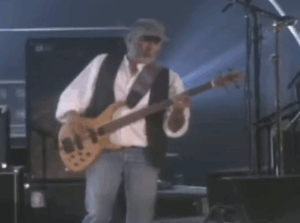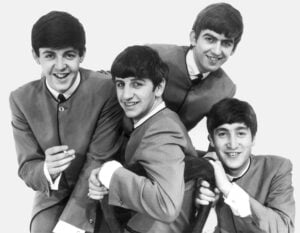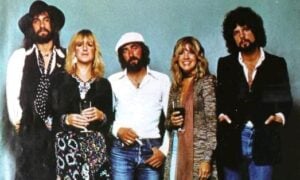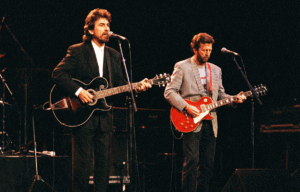20 1970s Worst Rock Songs Voted By Fans
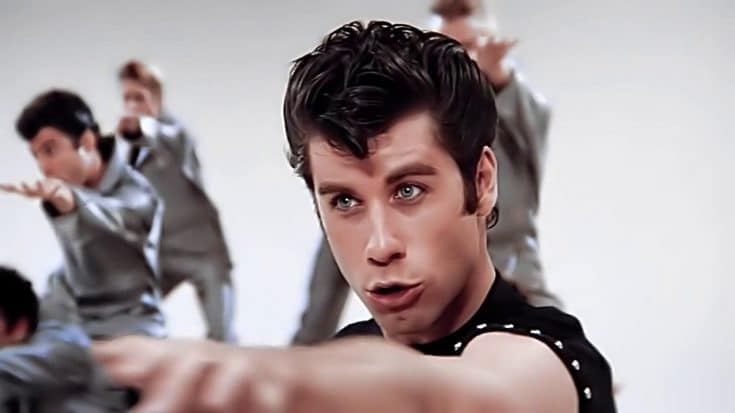
We don’t usually do “worst songs” lists here because we respect all artists and their creations, no matter the style or genre. But this time, we’re diving into tracks that seriously irritated rock fans. These songs either dominated the airwaves to the point of exhaustion or disrupted the vibe of great rock and roll. While not all were objectively bad, their constant overplay made them unbearable for many. Some tracks even sparked extreme reactions—like the infamous record-burning event in Chicago, where frustrated fans protested what they considered the worst songs of an iconic era. Here’s a look at the tunes that earned their spot on this unique list.
“Booty Time” – Disco Express
This list begins with a song that is memorable, but not in a good way. I was unable to even listen to it again and write about it! A humorous take on the disco era, “Booty Time” by Disco Express was used in the 1977 movie The Fist of Fear, Touch of Death. It tried to capture the excitement of the dance floor at the time with its lively lyrics and groove-heavy tune, but it went too far in the direction of novelty. Fortunately, it didn’t have a significant impact on the charts, while being notable for its campy appeal.
“Let Her In” – John Travolta
At the height of his Welcome Back, Kotte success, John Travolta shocked audiences in 1976 with the delicate pop ballad “Let Her In.” The song, which was written by Gary Benson and produced by Mike Lembo and Bob Reno, peaked at number 10 on the Billboard Hot 100. Even though it was successful on the charts, many rock fans weren’t impressed, praising Travolta’s limited vocal range and the song’s too romantic tone. The song didn’t feel so much like a display of musical skill as it did like a cash grab on his fame. We love John as an actor—Kotter and Pulp Fiction were greats—but Barbarino wasn’t it. I’m sorry, John.
“Remember Your A Womble” – The Wombles
Elisabeth Beresford’s well-known children’s book and television characters served as the inspiration for the novelty song “Remember You’re a Womble,” which the Wombles published in 1974. Mike Batt wrote and produced the song, which used lighthearted music to support the environmentally aware Wombles. It became popular with children and peaked at No. 3 on the UK Singles Chart, but rock fans were underwhelmed by its repetitious and cutesy style. It was seen by many as the emergence of gimmicky pop at the price of nuance and creativity. This song served as a perfect illustration of the conflict between novelty and serious rock in the 1970s, even though it brought back fond memories for some.
“Disco Lucy” (I Love Lucy Theme) – Wilton Place Street Band
The I Love Lucy theme is one of the most cherished and recognizable melodies in American television history. So, when the Wilton Place Street Band turned it into a disco track in 1976, fans of the classic show felt betrayed. Titled “Disco Lucy,” the reimagined version paired the iconic tune with a dance beat, riding the disco craze of the time. While it reached No. 24 on the Billboard Hot 100, many saw it as a cash grab that undermined the charm of the original. Like Meco’s disco take on the Star Wars theme, “Disco Lucy” highlighted the era’s habit of commercializing nostalgia.
“Basketball Jones” – Cheech And Chong
“Basketball Jones,” which was included on Cheech and Chong’s Los Cochinos album in 1973, is a funny parody of Brighter Side of Darkness’s soul ballad “Love Jones.” The song, which is sung by Cheech Marin as the lustful Tyrone Shoelaces, amusingly details his basketball fixation. The song’s unexpectedly deep comic tone was enhanced by its star-studded lineup, which included George Harrison, Carole King, and Billy Preston. Some rock fans were dissatisfied, though, as it rose to No. 15 on the Billboard Hot 100 despite its humor. “Basketball Jones” was a cult favorite and a source of annoyance for people who appreciated the emotion and content of music since it seemed like a lighthearted poke at their feelings.
“Young Love” – Donny Osmond
Released in 1973, Donny Osmond’s cover of “Young Love” brought a sugary twist to the 1956 hit originally recorded by Sonny James and later by Tab Hunter. Featured on his A Time for Us album, the track highlighted Osmond’s wholesome teen idol image, winning over fans but leaving rock enthusiasts unimpressed. While it climbed to No. 23 on the Billboard Hot 100 and reached No. 1 in the UK, its overly sweet tone symbolized the lightweight pop that frustrated rock purists. For those who craved grit and depth in their music, enduring this song even once was tough—but playing it on repeat? That’s a shortcut to madness.
“That’s Rock And Roll” – Shaun Cassidy
The song itself isn’t the problem with this one; it’s a great tune that Eric Carmen wrote for his 1976 debut album. The cover for Shaun Cassidy is the issue. Rock fans didn’t like Cassidy’s rendition, even though it shot to No. 3 on the Billboard Hot 100 thanks to his fame as a teenage idol. For a 15-year-old rock fan, this felt like a crime against the spirit of rock and roll, even though it was exciting to the 12-year-old females who loved Cassidy at the time. Cassidy’s rendition was successful, but it lacked the nuance and genuineness that made the original a classic.
“If” – Telly Savalas
Known for his renowned TV detective Kojak and his memorable big-screen appearances, the late Telly Savalas was a great performer. Fans loved his charm and skill, but many were baffled by his musical endeavors. Savalas seems to take his interpretation of Bread’s well-known song “If” very seriously, in contrast to William Shatner’s lighthearted, tongue-in-cheek spoken-word renditions. The footage of his performance speaks for itself. It’s undoubtedly a famous moment in pop cultural history, regardless of whether it was sincere or simply surprising.
“D.I.V.O.R.C.E” – Billy Connolly
Tammy Wynette’s poignant country ballad “D-I-V-O-R-C-E” was turned into a humorous novelty hit by Billy Connolly in 1975. In his rendition, Connolly displayed his incisive, irreverent humor by substituting absurd scenarios featuring a disobedient dog for the original story of loss. Listeners responded favorably to the song’s eccentric charm, which helped it reach No. 1 on the UK Singles Chart and solidified Connolly’s reputation for fusing comedy and music. Amazingly, a song this outlandish could be so popular in the middle of the 1970s, but Connolly’s distinct sound made it stand out.
“Johnny Reggae” – The Piglets
If the pet rock fad had come a few years earlier, the 1971 song “Johnny Reggae” would have had you grabbing for your pet rock to shatter the record. The song was a lighthearted spoof of the ska and reggae genres that were becoming more and more popular in the UK, and it was performed by The Piglets, a studio group founded by British producer Jonathan King. But rather than being a true tribute, its ostentatious lyrics and artificial accents came across as a caricature. Unexpectedly, the novelty song connected with listeners and rose to No. 3 on the UK Singles Chart, demonstrating that even the most bizarre tunes can find a following.
“Don’t Give Up on Us” – David Soul
David Soul, well known as Hutch from Starsky & Hutch, had an unexpected hit with “Don’t Give Up on Us,” which was released in 1976. Tony Macaulay’s poignant ballad, which peaked at the top of the US and UK charts, struck a chord with listeners who were drawn to its themes of hope and reconciliation. Many people loved it because of its passionate delivery and opulent orchestration, but rock aficionados condemned it for being too sentimental and representative of the late 1970s’ polished pop-ballad movement. Although a wide range of listeners found Soul’s soothing vocals appealing, the song brought to light the widening gap between the gritty rock sounds that dominated earlier in the decade and soft pop.
“Get Dancin’” – Disco Tex and the Sex-O-Lettes
Disco Tex and the Sex-O-Lettes’ 1974 single “Get Dancin'” perfectly encapsulated the flamboyant, extravagant spirit of the disco period. The song, which was written by Bob Crewe and Kenny Nolan, was an immediate hit and peaked at No. 10 on the Billboard Hot 100 thanks to its colorful verbal interjections and unrelenting dance beat. Rock aficionados felt its theatrical style lacked depth and longevity, while disco fans were drawn to its intensity and campy flare. Some thought it was less of a serious musical endeavor and more of a novelty performance. Despite differing views, the song is nonetheless a striking example of the disco craze at its most vibrant and unique.
“Feelings” – Morris Albert
Morris Albert’s 1974 single “Feelings” resonated with listeners all over the world, becoming a global hit and reaching No. 6 on the Billboard Hot 100. The song immediately became a romantic ballad due to its sweeping melody and poignant lyrics. But rock aficionados didn’t like its highly sentimental and tragic tone, which they saw as being too sweet. Its pervasiveness in parodies and talent shows over time only served to further solidify its divisive legacy. “Feelings” is still a controversial classic that causes controversy among music fans despite its economic success.
“Run Joey Run” – David Geddes
When David Geddes’ “Run Joey Run” was released in 1975, it became an unexpected smash and peaked at number four on the Billboard Hot 100. With spoken dialogue and a chorus performed by a female vocalist portraying the doomed Julie, the song, which was written by Paul Vance and Jack Perry, tells a melodramatic story of young love and tragedy. Although its dramatic storytelling won it a devoted following, critics frequently disregarded it as being too dramatic and awkwardly produced. For rock lovers, it was the perfect example of a novelty hit that lacked the gritty, genuine quality of the best songs of the decade. “Run Joey Run” is one of the most bizarre—and divisive—moments in 1970s pop culture, whether you like it or not.
“Afternoon Delight” – Starland Vocal Band
The Starland Vocal Band’s 1976 single “Afternoon Delight,” with its infectious harmonies and lighthearted lyrics about lunchtime romance, quickly became a pop success. The song, which was written by band member Bill Danoff, received a Grammy for Best Arrangement for Voices and shot to the top of the Billboard Hot 100. Despite its popularity, rock fans who were looking for something gritty found the song’s sweet delivery and continuous radio play to be annoying. The song’s ability to infiltrate your mind at the most ironic times hasn’t diminished, even though its humorous tone cemented its place in popular culture. And it is still stuck there!
“Torn Between Two Lovers” – Mary MacGregor
Mary MacGregor’s “Torn Between Two Lovers,” which was released in late 1976, quickly became a soft rock smash and, by early 1977, was at the top of both the Adult Contemporary and Billboard Hot 100 charts. The song, which was written by Phil Jarrell and Peter Yarrow of Peter, Paul, and Mary, relates a touching tale of romantic strife that resonated with a wide audience. But rock fans, who were missing the track’s unadulterated intensity and defiance, were dissatisfied with its sweet tone and well-produced sound. The song became a symbol of the emotional pop that frequently overshadowed gritty rock in the late 1970s as its airplay soared, solidifying its place as a commercial success and a contentious chapter in music history.
“Convoy” – C.W. McCall
C.W. McCall’s “Convoy,” released in 1975, capitalized on the CB radio craze and became an unlikely hit, soaring to number one on the Billboard Hot 100. Co-written by McCall and Chip Davis, the song tells a playful story of truckers banding together in a rebellious convoy. While its humor and cultural nods charmed many listeners, rock fans often dismissed it as a gimmick. The spoken-word delivery and twangy country backdrop clashed with the era’s heavier rock sound, making it feel like an oddball novelty. Though “Convoy” holds its place as a quirky snapshot of 1970s pop culture, it remains a polarizing tune for fans of more substantial music.
“You Light Up My Life” – Debby Boone
“You Light Up My Life” by Debby Boone, which peaked at number one on the Billboard Hot 100 for ten weeks in 1977, became a soft rock phenomenon. The song, which was written by Joe Brooks for the film of the same name, won over many listeners with its sweeping melody and poignant lyrics. However, rock fans who yearned for something with more unadulterated fire were irritated by its continuous airing. In contrast to the gritty edge of rock music, the song’s overly sentimental tone and well-produced sound seemed out of place. Despite being a huge economic success, “You Light Up My Life” represented the mellow, sugary trend that many rock fans were uncomfortable with.
“Disco Duck” – Rick Dees
The disco era was encapsulated in Rick Dees’ 1976 novelty single “Disco Duck,” which peaked at number one on the Billboard Hot 100. Some rock fans found it funny, while many were annoyed by its ridiculous idea of a Donald Duck-inspired voice combined with a funky disco tune. The song alienated listeners who wanted more somber music by becoming a symbol of disco excesses. As a target during the notorious 1979 Disco Demolition Night, “Disco Duck” even contributed to the backlash against disco. This song will always be associated with the onset of disco fatigue for many people. Be advised that you may need a strong stomach to see the video.
“Star Wars Theme/Cantina Band” (Meco Version)
Meco’s disco rendition of John Williams’ Star Wars theme went viral in 1977 and peaked at number one on the Billboard Hot 100. Both rock aficionados and ardent Star Wars fans felt deceived by it, even though it took advantage of the Star Wars fad and showcased Meco’s talent for turning orchestral music into dance smashes. The combination of disco beat and epic movie soundtrack represented the commercial excess of the time, extending disco’s influence into even the most revered cultural nooks and crannies. For a lot of people, this remix was the tipping point where disco really went too far. It claims the top rank because of this!

























